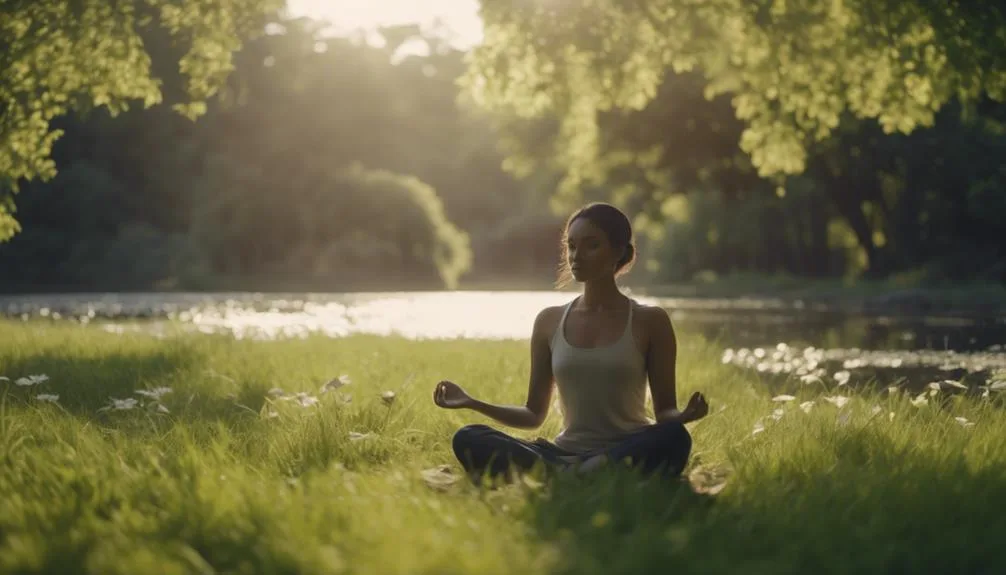Outdoor Meditation Unveils Nature's Inner Peace
In an era where the cacophony of urban life incessantly intrudes upon our mental space, the practice of outdoor meditation presents a compelling avenue for reclaiming tranquility. This method, grounded in the harmonious integration with nature, not only offers an escape but also a profound engagement with the present moment through the senses.
The juxtaposition of mindfulness techniques with the unfiltered backdrop of nature invites a unique exploration of inner peace. Yet, the journey to achieving this state of serenity through outdoor meditation is nuanced, encompassing various techniques and considerations that are pivotal for a truly transformative experience.
Key Takeaways
- Outdoor meditation enhances alertness by activating senses and reducing distractions.
- Nature's rhythm can align and synchronize with our body, fostering a deeper mindfulness experience.
- Walking and sound-focused meditations are particularly effective methods for engaging with the outdoors.
- Practicing meditation in nature can significantly reduce stress and improve mental well-being.
Nature's Meditative Power
Embracing the tranquil embrace of nature, individuals find that outdoor meditation ignites a profound connection to the earth, fostering inner peace and heightened mindfulness. This practice, set against the backdrop of natural serenity, activates the senses in a unique way, enhancing alertness and facilitating a deeper engagement with the present moment.
The natural environment acts as a catalyst for letting go of daily stresses, as the distractions of the modern world fade away, allowing for an undisturbed focus on the self and the surrounding natural beauty. The mindfulness benefits of such practice are manifold, including reduced stress, improved emotional balance, and a strengthened sense of well-being.
Outdoor Meditation Techniques
Several effective techniques exist for engaging in outdoor meditation, each designed to deepen mindfulness and enhance one's connection with nature. These practices support the harmonious alignment of our inner landscape with the external world, offering a respite from the hustle of daily life.
Here are three techniques to guide you:
- Breath Awareness: Focus on the natural flow of your breath. Inhale the fresh air deeply, letting it rejuvenate your body, and exhale slowly, releasing any tension.
- Mindful Movement: Engage in gentle, deliberate movements that connect you with your surroundings. This could be as simple as mindful walking or stretching, feeling each movement.
- Sense Immersion: Sit quietly and attune your senses to the natural world around you. Notice the sounds, smells, and the touch of the breeze on your skin.
These techniques invite a profound connection with nature, fostering peace and well-being.
Walking Meditation Explained

Walking meditation offers a unique opportunity to cultivate mindfulness by synchronizing one's movements with attentive breathing, deepening the connection between body and mind amidst the tranquility of nature. This practice, a form of mindful movement, invites participants to engage fully with the present moment, anchoring awareness in the physical sensations of walking.
By focusing on the rhythm of footsteps and the breath, walkers can achieve a meditative state that enhances sensory awareness and fosters a profound nature connection. The simplicity of walking in nature, perhaps through the immersive experience of forest bathing, allows for a seamless blend of movement and meditation.
This integration encourages a harmonious balance, inviting the mind to rest in the observation of nature's subtle details and the body's intuitive motion.
Sound Focus in Nature
Immersing oneself in the natural world offers an unparalleled opportunity to deepen one's meditation practice through the attentive listening to the myriad sounds that define the essence of the outdoors. This practice, known as sound focus in nature, can significantly enhance one's connection to the environment and inner self.
To truly enjoy and benefit from this experience, consider the following:
- Birdsong Meditation: Begin your day with forest immersion, letting the diverse melodies of birds ground you in the present moment.
- Stream Mindfulness: Find a stream and focus on its continuous flow; this sound symbolizes the transient nature of thoughts, encouraging a deeper nature connection.
- Silence Appreciation: Amidst these sounds, appreciate the silence, which offers a profound backdrop to the natural orchestra, fostering an inner sense of peace.
Grounding Through Sitting

After exploring the enriching practice of sound focus in nature, we turn our attention to the profound method of grounding through sitting, a technique that reconnects us to the earth and our inner selves with remarkable simplicity and depth.
This grounding practice encourages a deep earth connection, inviting us to physically and energetically bond with the ground beneath us. By sitting directly on the earth, we allow its natural vibrations to synchronize with our body's rhythms, fostering a sense of stability and calm.
This act not only enhances our mindfulness but also strengthens our relationship with the natural world, reminding us of our place within it. Grounding through sitting emerges as a cornerstone for those seeking serenity and a deeper bond with nature, embodying the essence of outdoor meditation.
Starting Your Meditation Path
Embarking on a meditation journey can be a transformative step towards achieving inner peace and heightened self-awareness. As you begin exploring mindfulness and finding serenity, consider these foundational steps to enrich your experience:
- Choose a Quiet Spot: Find a peaceful outdoor location where nature's embrace can enhance your meditation practice.
- Set Intentions: Reflect on what you wish to achieve—be it calming the mind, connecting with nature, or both. This focus will guide your journey.
- Start Small: Begin with short sessions, gradually increasing time as comfort with the practice grows.
Meditation is a personal exploration that unfolds at your own pace. By nurturing patience and openness, you'll discover the profound benefits of connecting with the world around you and the universe within.
Frequently Asked Questions
How Can I Ensure My Safety While Meditating in Remote Outdoor Locations?
To ensure safety while meditating in remote locations, carefully secure personal belongings and remain vigilant of potential wildlife encounters. Adopting a mindful approach towards your surroundings can significantly mitigate risks, fostering a serene meditation experience.
What Are the Best Times of Day for Outdoor Meditation to Maximize the Benefits of Natural Light and Temperature?
The optimal times for outdoor meditation vary, considering seasonal impact and personal comfort. Early mornings or late afternoons, when natural light and temperatures are most soothing, significantly enhance the meditative experience and align with bodily rhythms.
How Can I Maintain My Meditation Practice Outdoors in Adverse Weather Conditions?
To maintain outdoor meditation in adverse weather, consider using weather-appropriate gear or seeking indoor alternatives that provide a nature-like ambiance. This approach ensures your practice remains consistent, supportive, and conducive to inner peace.
Are There Specific Types of Natural Environments That Enhance the Meditation Experience More Than Others?
Certain natural environments, particularly urban parks and beaches, can significantly enhance the meditation experience, offering unique benefits such as heightened sensory awareness and a profound sense of tranquility through exploration and the soothing sounds of nature.
How Can Individuals With Mobility Issues Adapt Outdoor Meditation Practices for Their Needs?
Individuals with mobility issues can adapt outdoor meditation practices by utilizing assistive technology and meditation cushions to ensure comfort and accessibility. These adaptations foster an inclusive environment for experiencing the tranquility of nature's surroundings.
Conclusion
In conclusion, outdoor meditation serves as a bridge to tranquility, much like a serene river flows gently into the vast ocean of calm.
By intertwining the essence of nature's peace with mindfulness techniques, individuals can cultivate a profound sense of serenity and well-being.
This practice not only fosters a deeper connection with the environment but also enhances mental health, making it an essential pursuit in the quest for inner peace.
Embracing outdoor meditation invites a transformative journey towards a harmonious and balanced life.






